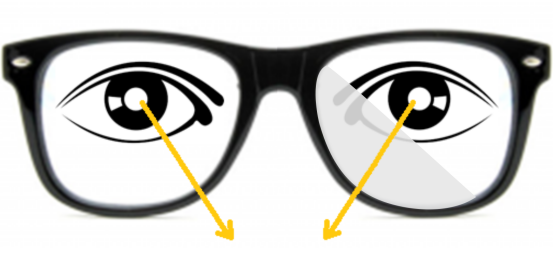Dyslexia & Eye Dominance
 The majority view is that dyslexia is a language problem. Those who consider that low level visual and auditory skills also play an important role do not usually consider these to be the cause of dyslexia however they argue that training such skills can be beneficial in treating some of the symptoms experienced by dyslexics.
The majority view is that dyslexia is a language problem. Those who consider that low level visual and auditory skills also play an important role do not usually consider these to be the cause of dyslexia however they argue that training such skills can be beneficial in treating some of the symptoms experienced by dyslexics.
In contrast, a group of Italian researchers claim that visual deficits do play a causal role in dyslexia and that training targeted visual skills can improve learning outcomes in dyslexic children and adults.1 More recently, French physicists Ropars & LeFloch found a possible mechanism to explain why these visual deficits may occur.2
They claim that the receptor pattern in the central part of the eyes known as Maxwell’s spot centroids (discovered by the famous physicist James Maxwell) differs in dyslexics from that of non-dyslexics resulting in dyslexics lacking a dominant eye. This central spot can be mathematically defined in terms of how circular or elliptical it is. In the case of dyslexia the spots are circular in each eye, whereas in non-dyslexics one spot is circular and the other is elliptical with the circular spot corresponding to the more dominant eye. If both spots are circular however this is equivalent to having two dominant eyes leading to a perceptual phenomenon known as “retinal rivalry” whereby the eyes are constantly competing with each other. This would likely have an inhibitory effect slowing down the development of the fast (magnocellular) visual pathways along with any associated cortical areas in the brain required for rapid word identification.
What Can Be Done?
To treat this would require preventing any rivalry occurring between the eyes. This could be done for example by using alternating flicker glasses (like the glasses used in 3D movies) or simply by covering one eye. Although this would not likely deliver any immediate effects in making reading easier, if done regularly whilst reading it could have an impact on visual/cortical development over time. This is analogous to the finding that electrical stimulation to the non-affected side of the brain in stroke patients can facilitate faster recovery of function by preventing the non-affected side of the brain from trying to take over. In both cases the interventions aim to prevent inhibitory effects from the brain itself.
Such treatments are considered to be “bottom-up” because they do not require a conscious effort to achieve better performance. By contrast, therapies such as iCept are considered to be “top-down” because they require a conscious effort that involves daily training. The optimum solution is most likely a combination of BOTH since one approach allows the changes to happen more readily while the other approach aims to accelerate normal development. That said, is there any evidence to show that covering one eye can lead to better reading performance?
Yes, a placebo controlled study by Stein published in the Brain journal (2000) found that covering the left eye when reading was effective at improving reading in dyslexic children with a subtle eye wobble. They reported the reading rate nearly doubled after 6 to 9 months of therapy which was significantly greater compared to other remedial techniques. In this study the focus was primarily around improving eye stability which is only one of a number of visual deficits experienced by dyslexics. Covering one eye however may actually affect multiple visual skills and prove to be an effective therapy irrespective of eye stability.
Practical Solutions
A drawback of covering one eye is that most kids dislike wearing patches! Even if they are fine with it having the full visual field blocked on one side can feel uncomfortable. An alternative would be to block only that part of the visual field required for reading and leaving the rest unaffected. This can be achieved by occluding the nasal portion of vision using glasses and translucent sellotape (Scotch Magic Tape). Although not a proven intervention for dyslexia it is supported by research and has a good theoretical basis. With that understanding in mind this is something we are trialing for interested parents. If the student already has glasses then it only costs the price of a roll of sellotape!
patches! Even if they are fine with it having the full visual field blocked on one side can feel uncomfortable. An alternative would be to block only that part of the visual field required for reading and leaving the rest unaffected. This can be achieved by occluding the nasal portion of vision using glasses and translucent sellotape (Scotch Magic Tape). Although not a proven intervention for dyslexia it is supported by research and has a good theoretical basis. With that understanding in mind this is something we are trialing for interested parents. If the student already has glasses then it only costs the price of a roll of sellotape!
 References
References
1. Gori S, Seitz AR, Ronconi L, Franceschini S, Facoetti A. Multiple causal links between magnocellular-dorsal pathway deficit and developmental dyslexia. Cerebral Cortex 2015, Sep 22;1-14.
2. Le Floch A, Ropars G. Left-right asymmetry of the Maxwell spot centroids in adults without and with dyslexia. Proc Biol Sci 2017, 284(1865).
3. Stein J, Richardson AJ, Fowler MS. Monocular occlusion can improve binocular control and reading in dyslexics. Brain 2000, 123(1):164-70.
